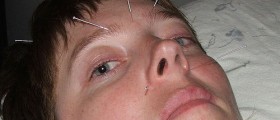
What is Bell's palsy?
Symptoms of Bell's Palsy
Along its long path the nerves go through a tiny bone channel. It is believed that swelling of this particular part of the nerve causes Bell's paralysis. This medical condition typically features with weakness of facial muscles on one half of the face. The weakness can be mild or rather severe one when a person actually cannot close the eye or mouth and cannot frown. The disease starts acutely and facial paralysis can fully develop within one or two days.The corners of the mouth are asymmetrical and a patient may complain about excessive production of tears on one side of the face. The muscles are so weak that if a doctor asks a patient to blow his/ her cheeks, the cheek on the affected side will stay flat.
The affected area is most commonly numb and additional problems may include changes in sense of taste or hearing.
Treatment of Bell's Paralysis
In patients who are suffering from severe symptoms the first thing to do is to prevent damage of the eye. Namely, patients cannot close the affected eye ant this can lead to dryness and even erosions of the cornea. This is why the doctors recommend dark glasses during the day, persistent usage of artificial tears and special ointments which are applied during the night when the eye is covered with gauze.
In majority of patients the inflammation of the facial nerve is treated with oral corticosteroids. This can be effective in reduction of recovery period.
In severe cases when the weakness of facial muscles cannot be treated with medications a surgical decompression of the nerve is performed. This procedure provides with best optimal results if conducted within two weeks after the initial sings of the palsy. After that period of time, the nerve damage is irreversible. One possible complication of the surgery may be hearing loss.
Fortunately, most of the patients recover completely or suffer from mild sequelae. Remnant imperfections can be treated with plastic surgery.

















Your thoughts on this
Loading...